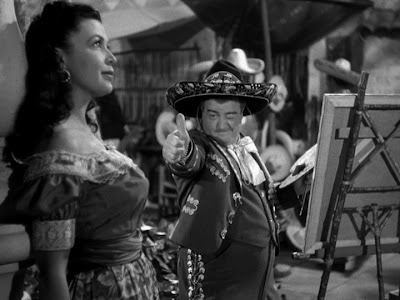Starring: John Hudson and Peggy Webber
Director: Alex Nicol
Rating: Three of Ten Stars
"The Screaming Skull" is at its best before the movie actually starts. There is a gimmicky bit where the producers promise to pay the funeral costs for anyone who dies of fright during the movie's climax. It's far more likely that a captive audience member will die of boredom or irritation before the movie runs its course, so the producers will never have to deliver on their promis, as that little bit is more chilling in a corny sort of way than most of what follows.
This is a would-be thriller with the now well-worn backdrop of a widower marrying a one-time institutionalized (but very rich) woman, moving back to the isolated old mansion he shared with his first love, and the fragile psyche of the new wife either starts unraveling, or perhaps she is really being haunted by the jealous ghost of the original lady of the house... or maybe someone is trying to drive her insane again.
I can't fault the film for its I've-seen-this-a-hundred-times-before plot, because it dates from 1958, but I do fault it for being just plain bad. The script is awful, and the acting is worse. There are only two things the filmmakers do right--first, they reveal the source of Jenni's (the mentally frazzled rich wife) terror at just the right moment in the film; second, they successfully manage to convey the woman's deteriorating sanity and growing sense of isolation).he acting is worse. In fact, the only actor who delives even close to a passable performance is Russ Conway, who plays Reverend Snow.
I will also grant that the final ten-fifteen minutes of the film are actually not bad in a third-rate horror movie kinda way. But the ending isn't so good that it makes up for suffering through what led up to it. (And the filmmakers back off from making the ending as powerful as it SHOULD be by wimping out when it comes to Jenni's mental health, or lack thereof.)
Other positive notes are that aside from portions of the ending, there are a few other genuinely creepy moments, such as when Jenni is left alone in the house (which is suddenly filled with animated skulls). There are also some very nice shots of her roaming the house, and of the mysterious, shadowhaunted, vegetation-choked grounds that surround the southern mansion where the movie takes place that show some glimmer of talent on the part of the cinematographer and technical crew. Unfortunately, every time the actors open their mouths to deliver badly written dialogue with a level of acting ability that might not even get them into a high school play, whatever gains the movie made it loses. The leading lady, Peggy Webber, is a great screamer, but that's all she's good for (although I suspect the scene of her stripping down to her bra and panties was pretty racey in its day, so maybe we can list stripping among her talents).




























.jpg)
